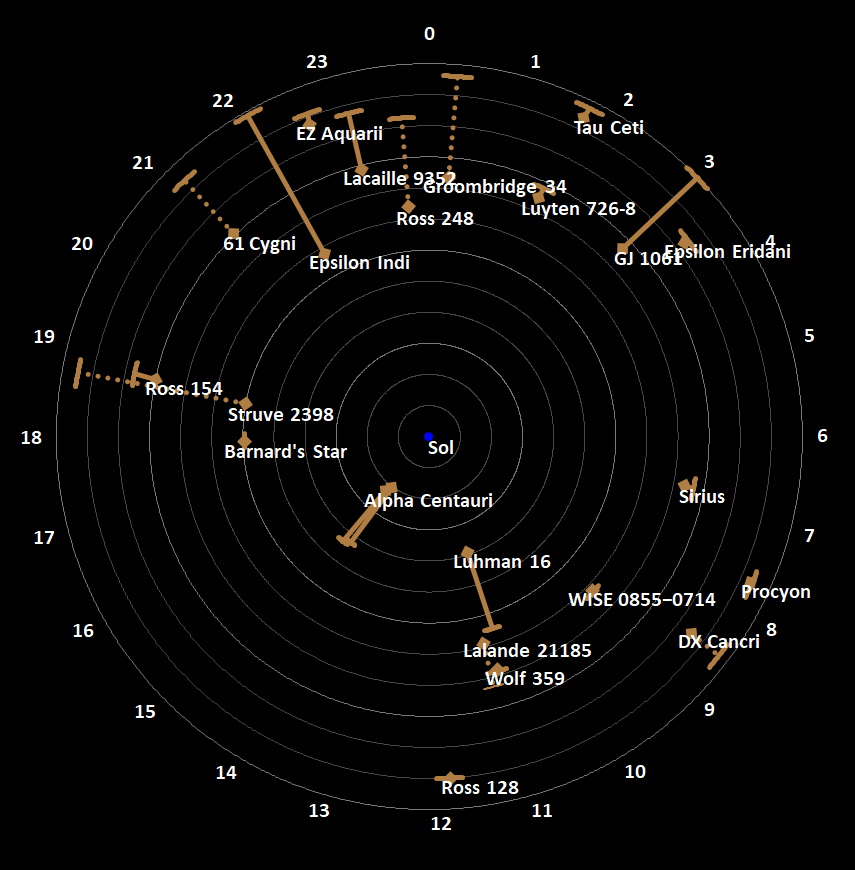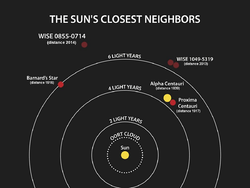Angular map of fusors around Sol within 12ly (large)
How to read:
This map is a common radar screen type of map displaying stellar objects around Sol. Each stellar object is marked jointly by two points, a diamond marked point and an line marked point, as well as an either unbroken or dotted straight line which connects the two points.
Circular lines:
The circular lines indicate the distance from the map-center by being set apart in one light-year steps. At the outermost circular line the hours angle for the right ascension is displayed clockwise. The circular lines therefore represent the hour-axis and, through their repetition in one light-year steps, the distance-axis.
Stellar object points:
- The diamond marked points display the location of the stellar objects in the third dimension according to their declination.
- The line marked point are at the distance of the stellar objects from the map-center in light-years (ly) and are found on the map as endpoints of the straight lines which radiate outward from each diamond marked point. Contrary to the diamond marked points, the line marked point are all on the reference plane/level of the map.
Straight lines:
The straight lines (unbroken or dotted) represent the arcs of the declination angles (see also circular sector of a unit circle) of the stellar objects on their hour circle toward the celestial poles (with the poles being congruent with the center of the map). Since the map is viewed top-down from the south, allowing a clockwise eastward-reading (opposed to when using sidereal hour angles), the dotted straight lines are arcs with positive declination, down from the reference plane/level, toward the star Polaris, the northern celestial pole (which would be allmost congruent with the center of the map, if it would display stars further than 12 ly). That said the straight lines also represent a top-down view of the hypotenuse between the points of a right-angled triangle with its right-angle on the plane/level; but the straight lines, when viewed true to length, represent the base x-line of the described triangle.
Calculation of the length of the displayed straight lines is:
x = "distance of the stellar objects to the map-center in ly" - ("distance of the stellar objects to the map-center in ly" * sin(180°-90°-"declination"))

Note: Proxima Centauri is the only marked stellar object not labled and not being an independent stellar object or the primary body of a stellar system (which in its case is Alpha Centauri), but still being noteworthy since it is the closest fusor to Sol.
Epoch J2000.0, see List of nearest stars and brown dwarfs.
Produced with Microsoft Excel (radar chart)Relevante Bilder
Relevante Artikel
Liste der nächsten extrasolaren SystemeDie Liste der nächsten extrasolaren Systeme umfasst die der Sonne bzw. der Erde nächstgelegenen Systeme von Sternen und Braunen Zwergen einschließlich umlaufender Planeten und Asteroidengürtel bzw. Trümmerscheiben bis zu einer Entfernung von 20 Lichtjahren. Ein großer Teil dieser Sterne befindet sich in der Lokalen Interstellaren Wolke. .. weiterlesen



